The Spring 2011 Anime Preview Guide
Tim Maughan
by Tim Maughan,
After being introduced seriously to anime by Akira in 1991, he became a Katsuhiro Otomo fanboy, a Studio Ghibli fanatic and a Mamoru Oshii obsessive. His favourite subgenres are sci-fi and realistic mecha, and if he did have a dakimakura hug pillow it would be of a Shinohara Heavy Industries ARL-99 Helldiver Paradrop Labor. But he doesn't.

Deadman Wonderland
Rating: 3.5 (out of 5)
Review: Ganta is having a bad day. One minute he's checking out the back of some girl's head, when a glowing floating man turns up hovering outside his classroom window. Which in itself isn't that bad, but before you know it he's unleashed some sort of super psychic weapon thing and massacred everyone apart from Ganta, before shooting some sort of diamond into his chest. He passes out, only to wake in hospital to find out he's been charged with killing his classmates. At the trial he's found guilty and sentenced to death when his own phone ‘accidentally’ reveals some faked footage of him confessing to everything, prompting the dad of the girl whose head he was ogling to beat him to a bloody pulp on the courtroom floor.
Sheesh, don't you just hate it when that happens?
But that's not all that happens in the first episode of Deadman Wonderland, which is perhaps both a blessing and a curse. While there's no filler and the show jumps straight into the main action-packed storyline, the speed at which everything happens leaves it all feeling a little unbelievable. I mean really – after the architecture wrecking attack on the school, who would believe tiny little Ganta is responsible? Evidently there's a high level conspiracy going on for some reason, but with little exposition or world building so far it's a lot to swallow. With Ganta locked up in the private prison/theme park off the title we are left knowing nothing about the outside world at all, and the show starts to feel like it might be skipping chunks of the manga it was based on. To make matters worse, what looks initially like it could be a wholly original project starts to spit out some depressingly familiar anime tropes. There's the albino looking magical girl who talks like she's of sub-normal intelligence and always in the third person. There's the glasses-type moe girl that's completely ineffectual and you can't work out how she could ever get a job as a guard in a high security prison. Oh, and there's a joke about big titties. Sigh.
Don't get me wrong – Deadman Wonderland has a lot of potential. The premise and setting will hopefully lead to a great combination of satire, commentary and violent action. But compared with Tiger & Bunny this first episode feels a bit rushed, and that it might be confusing violence with maturity.
Deadman Wonderland is available streaming on Crunchyroll.

Toriko
Rating: 4 (out of 5)
Review: Toriko can perhaps be best summed up by the lyrics of the show's opening song:
“GUTS! CHOMP! GUTS! CHOMP CHOMP!”
Our eponymous hero is a hunter, tracking down and killing WITH HIS BARE HANDS some of the world's rarest animals to turn into delicious dishes. He's approached by trainee teenage chef Komatsu to bag an ultra-rare and dangerous Galala Crocodile for a feast he is preparing for a tense summit of world leaders. In other words: world peace relies on the delivering of some prime crocodile steaks. Yes, that's right readers: quite literally THE STEAKS ARE HIGH.
Sorry.
Toriko is that kind of insane, ridiculous genius that only anime can produce. It's one of those uber-manly shonen shows that tick all the required boxes: huge monsters, transformation sequences, crazy landscapes and a big dose of putting its tongue in its cheek. It also uses RPG/card game tropes to good effect to mesmerize its target audience, giving it a slight Monster Hunter vibe.
Sure, if you're a vegetarian this might not be your bowl of lentils - but even as someone that finds the concept of real-world hunting for sport tasteless, I didn't once feel any qualms at watching Toriko. Mainly because this is so far from real world hunting it's hard to draw any kind of parallel between the two. For a start the creatures are so over the top and ludicrously named (‘Friday Monkeys’! Brilliant!) and the way they are taken down is so unbelievable that it resembles watching a series of video game boss battles rather than someone shooting clueless deer with a high–powered rifle. There's a real sense that our heroes may be in danger when tackling these beasts – something that one-sided modern hunting sadly lacks. Similarly the eating scenes are so ridiculous – imagine the dinosaur steaks from The Flintstones – that it's hard to see how this could be glamorizing meat eating. Although I must admit it did make me hungry, but that may be just because I was watching it on an empty stomach.
I'll admit I don't watch many shonen shows at all, as most of them seem unable to hold my attention. But Toriko's brash style and above par production values had me gripped and giggling for its whole duration, and left me satisfyingly full and my mouth watering for a second helping.
Toriko is available streaming at Hulu and Funimation.com.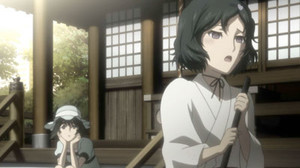
Steins;Gate episode 2
Rating: 3
Review: Okarin's mental state is no clearer by the end of Steins;Gate's second episode, and neither is exactly what is going on. The girl he thought he saw brutally murdered earlier in the day is now alive and well, and all traces of the alleged time traveller he remembers spending years researching has disappeared not only from the Internet but also his bookshelves. It's clear either someone really is manipulating time in order to re-write history, or his paranoid delusions are becoming increasingly convincing.
Steins;Gate drops a point from last week for a couple of reasons. Firstly the creepy, reality twisting atmospheres of the opener seem to have been toned down, with the whole show feeling a lot more conventional in its presentation. It's perhaps not that surprising, but certainly disappointing. Similarly the show's content feels far more conventional this time around. Instead of the ‘what the heck is going on’ exposition-less approach of the first instalment, most of this episode seems to be filler, spending a little too much time introducing some pretty uninteresting and generic new characters. There's even a scene set in a Akihabara maid café, which could have been lifted from any number of dull otaku shows of the last decade. The overall effect is less than satisfying, with the show threatening to become far more run of the mill than my previous Satoshi Kon comparisons may have suggested.
All that said, the overall premise is still intriguing, and the production values still seem quite high – if also lacking the hint of experimentalism the first episode promised – meaning that it hopefully will be worth giving it a few more instalments to see what happens.
Steins;Gate is available streaming on Crunchyroll.

Tiger & Bunny – episode 2
Rating: 5 (out of 5)
Review: What's your taste in humor? Slapstick? Snarky bickering? Satire? Do you like action? Big, Hollywood movie-style city smashing action? How about a dashing of feel-good schmaltz? Welcome to episode 2 of Tiger & Bunny, and all of the above in under 25 minutes.
Last week's premiere suggested something – that Tiger & Bunny was a smart show. The combination of action and satire is rare in anime these days, and it's even rarer when it works. That was probably the biggest concern after episode one; that sustaining that level of smart, fresh quality would be tricky. But with the satirical exposition and world-building out of the way the show has narrowed its focus to a smaller, more personal level. And that's not just with the plot, but with the humour too. Instead of big wide stabs at commercialism and Japanese pop culture (although they are there too) the gags mainly come at the expense of characters and relationships.
Examples? It's hard to know where to start, as this episode is crammed full of genuine laugh out loud moments. There's the opening shot of our hero moaning and looking ridiculous in a futuristic motorbike sidecar. There's the buddy-movie style banter between our odd-couple protagonists. And there's what is meant to be a poignant flashback scene that left me – quite intentionally – in fits of giggles.
That's not to say the satire is gone this episode – but rather than the commercialisation of anime being the target, a slightly more gentle – but no less funny – finger is pointed at the conventions and tropes of US superhero mythology. We all know about ‘with great power comes great responsibility’ and the ‘loneliness of the masked hero’ – and it's to the writers’ credit that Tiger & Bunny deals with them in a way that is both respectful and firmly tongue-in-cheek. It also manages to drop its gags beat-perfectly into an action sequence that not only dominates the show's running time, but looks just as polished as last week. In fact, it might even look better – certainly the CGI didn't seem as jarringly awkward as it did occasionally during episode one. Even at only a week into the new season, it's starting to look like Tiger & Bunny will take the crown.
Tiger & Bunny is available streaming at Hulu, VizMedia.com and here on ANN.

Astarotte's Toy
Rating: 1 (out of 5)
Review: You almost certainly know the premise of Astarotte's Toy already, so let's cut to the chase: this is that show about the 10 year old princess from a fantasy realm that has to fellate human men (or animals!) in order to survive.
The first thing that needs to be said is, that despite riding on that premise, the show is extremely tame. In fact apart from opening on an extended, steam obscured scene of a bunch underage girls bathing there's not much in the way of sexy fanservice even. This is far more of a moe show than a hentai one, seemingly aiming for its fans to be fawning over the girls rather than masturbating over them. Which begs the first question: why have any sexual content or premise whatsoever? I'm constantly told by moe experts that the subgenre has nothing at all to do with sex, and in fact many of them act with repulsion at any hint or suggestion that it does.
In fact, the inclusion of the sexual aspects of Asarotte's Toy baffles even more on further reflection. If 2D underage succubuses (Succubae? Succubi?) are your fetish then I'm sure Google is your friend – the internet must be full of actual hentai anime and manga that will float your boat. Similarly, if you live in Japan (well, not Tokyo perhaps) you can probably pick far more explicit stuff up at your local manga store. It seems that the only real reason for this show's premise is to draw attention and create a minor controversy.
Which is probably exactly the reason it might gain a fanbase outside of Japan – it'll appeal to that highly vocal minority of foreign otaku that still view anime as some kind of outrageous novelty product, who like to jump up and down point at the crazy Japanese cartoons. You know the type – the kind of self proclaimed otaku that see their fandom as some kind of strange rebellion against everyone, and as a way to draw attention and create a minor controversy. Not that there's anything wrong with that at all – rebellion in itself can be extremely healthy and refreshing – but you'd just wish people could find something a little less generic, disposable and tame to rebel with.
Astarotte's Toy is available streaming at Crunchyroll.
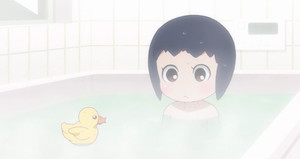
Hen Zemi
Rating: 0 (out of everything)
Review: Nanako is a college student who, despite seeming to be a well adjusted and shy girl, is attending a class on hentai. Why is she doing this? Is it because she has an interest in the cultural significance of pornography? Or because she wants to major in psychology and work in the area of sexual development? Don't be ridiculous! This is anime! Nanoko is a girl! She is doing it because there is a boy she likes in the class.
This season's reoccurring theme seems to be anime comedies that are not actually funny. Hen Zemi is the latest addition, and at just over 12 minutes long there's no reason to expect any depth from this simple gag show. Just make sure you don't expect any laughs either.
What did surprise me about Hen Zemi was how slightly sinister it felt at times. The girls in the show are depicted as nothing but objects, which the male characters try to manipulate and pressurise into ‘owing’ them favors or letting them grope them. Again, it's a short gag show, but this kind of tiresome misogyny is probably one of the main reasons it's not in the slightest bit funny.
If sex is something distant and alien that you still snigger about, then Hen Zemi might have something for you. Everyone else should probably stay away, unless you really must see the cheapest looking 12 minutes of animation this season.

Yondemasuyo, Azazel-san
Rating 4 (out of 5)
Review: Young girl Sakuma has a part time job working for the mysterious Black Jack like detective Akutabe, who summons demons to help him with cases. When a furious housewife comes to him to get revenge on her cheating husband, he gives Sakuma the use of the Azazel, a lust demon whose formidable power is underplayed by the fact he manifests as an adorable kawaii plushie. Hilarity ensues.
Which is a bit of a relief, as most of the 12 minute comedies this season – of which this is also one – have been quite lacking in laughs. Yondemasuyo, Azazel-san brings the funny with a bunch of gross out sight-gags, mainly based around blood loss and humping, but also has a far more knowing and witty streak. It seems to taking aim at not only the horror genre but also anime in general – this first episode makes fun of fan service as well as the way moe otaku seem obsessed with their heroines remaining virgins at all costs. It's refreshing to see some adult humor that doesn't rely on sexual embarrassment for once.
As well as being funny the show looks pretty good too. I'd always thought these half length shows looked crappy because of budgetary restrictions, so either Yondemasuyo, Azazel-san has been given an extravagant purse or its staff are just more experienced and talented. The latter could certainly be true, considering this comes from famed studio Production IG – which in itself is enough for most anime fans to want to check it out.

SKET Dance
Rating: 1.5 (out of 5)
Review: Generic anime setup number 5: Shy boy is transferred to a new school in a new town, within minutes of being there bumps (literally, and hopefully in some slightly embarrassing way involving a misunderstanding) into an excitable or kooky girl that in turns introduces him to her group of friends. This group of students then spend the rest of the season bonding and getting past social differences and problems, before becoming BEST FRIENDS FOREVER!
SKET Dance bills itself as a comedy, which is where the problems start. It's just not funny. The group that new kid Teppei falls in with are the SKET (Support Kindness Encouragement Troubleshoot) club, and while their character designs suggest they might be a bit edgy and crazy, they are actually just three rather dull do-gooders. Helping other school kids out with problems with bullies and school life is an admirable and wholesome activity, but sadly it doesn't leave many opportunities for comedy or action. I mean, it's not like they're secretly ninjas. Or that the school bullies ride cool mecha. Or that the school is actually built on the site of an ancient massacre where a group of bandits were wiped out by a noble lone samurai, who it turns out is an ancestor of Teppei, and now the bandits’ souls are rising up and possessing the bodies of the bullies so they can take bloody revenge. Or, you know, anything interesting.
Maybe that is a little harsh – SKET Dance does exactly what it sets out to do: create a thoroughly safe, wholesome and unchallenging show for tweens that want to be teens but are understandably a little bit scared of the whole business. It takes them by the hand and reassures them that life will be fine, and when you get bigger you'll still have good friends you can have fun with. At least I hope that's who this show is aimed at. The rest of us can learn one interesting thing from this first episode: that the making of generic, unchallenging children's’ TV is the same the world over – dominated by old men in suits that still believe kids are happy with just competent production values and bland 80s pop-rock soundtracks.
Sket Dance is available streaming at Crunchyroll.

Dororon Enma-Kun Meeramera
Rating: 4.5 (out of 5)
Review: It's said that Harumi's elementary school is haunted by a bizarre collection of subterranean Japanese demons. When her and her friends set out to investigate these paranormal rumors, they not only find out that they are true, but that a face stealing yokai is on the rampage. Teaming up with some of the more bizarre looking, if friendlier, supernatural beings, they attempt to take it down and banish it back to hell.
This is the third attempt at adapting Go Nagai's classic children's horror-comedy manga into an anime, and the fact it is being tried yet again shows how popular his work still is in Japan. I've always considered Nagai to be an interesting parallel to “God of manga” and Astroboy creater Osamu Tezuka – while both wrote stories for all age groups from small children to adults, Nagai's approach was always a little more edgy. Nagai's children's works are almost a response to the sensible, intelligent kid's tales of Tezuka - and that's evident here. It's loud and bawdy instead of clever and moralistic, with its fair share of naughty, puerile schoolboy humour jokes - but they feel fine here in this context, as this is a show primarily for naughty puerile schoolboys. If I were eight years old watching this now, I'd probably be rolling round the floor in fits of snotty giggles and screaming for more.
The truth is I was eight nearly 30 years ago, but I still really enjoyed this first episode. I might not have been rolling around, but I did giggle more than a few times. More frequently I was grinning with glee. The show is gorgeous, knowing exactly how and when to balance spooky darkness with brightly colored, in your face fun. The character designs stand out for their energy and uniqueness, and hopefully one of the joys of the series will be the bizarre looking monsters and supernatural creatures that the show's creators dream up for each week. It instantly reminded me of not only the first time I encountered Nagai's work, but also that of creators like Leji Matsumoto and Rintaro in its on-screen energy and they way it revels in doing things that can only be done in anime. In other words its good old-fashioned fun, and one to watch if you just enjoy well-made, exciting animation.

Steins;Gate
Rating: 4
Review: Okarin is either one of two things: 1) a mad scientist fighting a worldwide conspiracy by the mysterious Agency who is manipulating the flow of time, or 2) a schizophrenic otaku suffering from severe paranoid delusions. The problem is, at times, even Okarin himself doesn't seem sure which is true.
Anime shows based on visual novels often feel inadequate when it comes to story, but Steins;Gate has one of those intriguing science fiction plotlines that instantly has you guessing and theorising as to what is really going on. It throws the audience in at the deep end – there's no exposition at all in the first half, despite several strange events and major plot points. It can be a bit bewildering to watch at first, but this is clearly the writer's intent – it is vital for the show's unique style to work that the viewer instantly questions Okarin's sanity, and the first half's chaotic editing and seemingly random narrative certainly accomplish this. It's not until the second half that characters are formally introduced and some background story are provided – but the latter takes the form of more of Okarin's paranoid ranting, further suggesting this might all just be a figment of his crazed imagination.
In fact Okarin's outbursts and nonsensical rambling could start to get tedious after a while, but at least in this first episode Steins;Gate's creepy, disconnected atmosphere stops that from ever happening – if anything, they become more disturbing. Atmosphere is Steins;Gate's best asset – the combination of its stark, cold art style and minimal soundtrack of ambient noise gives it an uncomfortable but appreciated edge. Combined with some skilfully confusing editing and its questioning of reality and the reliability of memories, the result is a show that is trying to resemble the work of the late Satoshi Kon rather than other conspiracy shows like the slightly wimpy Eden of the East. Whether it can manage that for an entire series is the big question, but this episode is intriguing enough to make you stick around to find out.
Steins;Gate is available streaming at Crunchyroll.
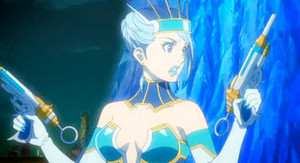
Tiger & Bunny
Rating: 4.5
Superheroes. You know the standard set-up: ordinary people start to emerge that have unique and fantastic powers, some of them turn to crime while others turn to vigilantism. Good vs. Evil and the responsibility of power, it's the basis of every caped crusader story since the time began (well, up until Alan Moore wrote Watchmen, arguably). But what if things didn't work out quite like that? What if, instead, you could only legitimately fight crime if you had the official backing of a corporate sponsor? What if your ratings, celebrity status and performance in front of the cameras were more important than catching the actual crooks? Welcome to the city of Stern Bild.
Tiger & Bunny is so far the most interesting concept for an anime show this season, and may in fact be one of the most interesting ideas in anime for quite a while. At a time when the industry has to fill every show with product placement and sponsorship deals, watching a story about exactly how those things work is fascinating. For a start, when watching a hero being told how to do their job by a sponsor that is breathing down their neck it's hard not to wonder if the writer or director is relating a personal experience. Oh, and don't forget that some of the heroes are sponsored by real world companies like Pepsi, Ustream and Soft Bank, presumably meaning that the studio is receiving money actual money from them and making the relationships in the story even more interesting. Likewise when it is announced that the award ceremony song will be sung by one of the heroes - and is also available to buy - its impossible not to be reminded of those god awful OP and ED songs that are on every show these days, bear seemingly no relevance to the story, and are really just there to launch the careers of whatever Z-list pop starlet Sony music are trying to sell this season. Tiger & Bunny seems to be talking about a lot of things – from the commercialisation of the superhero genre through to reality TV – but most importantly it wants to tell you something about the state of the anime industry today.
For some of us (well, me) that on its own would probably be enough to make it worth watching, but Tiger & Bunny has a lot more to offer. For a start, it's very well written, with some great dry humour and snappy dialogue. It also flies in the face of modern convention by making its main protagonist middle aged – he even has a kid to support, who he doesn't get to see often enough due to superhero work commitments – meaning that it instantly has a more mature feel, despite the brightly coloured costumes and action sequences. Speaking of which: the show opens with an action sequence that must be at least 8 minutes long – something I've not seen done in a first episode for ages – which cleverly not only introduces the characters but also the setting and concepts without the need for lengthy exposition. If the show does have any setbacks it's on the visual side, sadly. There's an over-reliance on CGI – something that is unavoidable in the industry's current economic climate – and I'm not convinced by some of the character designs, which while clearly meaning to reference mecha and tokusatsu designs, look a little too tacky in places. But to be fair, that is probably the point. And that in itself is a rarity– an anime show with more than one point it wants to make – meaning that Tiger & Bunny is not to be missed this season.
Tiger & Bunny is available streaming at Hulu, VizMedia.com and here on ANN.
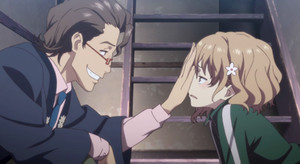
Hana-Saku Iroha
Rating: 2.5
Review: Ohana is 16 years old and loves to romanticize and over-think her life in the way only teenagers and sexy vampires can. She is desperate for some drama to come along and shake up her life, and she gets her wish when her horrendously selfish mother runs off with her debt ridden boyfriend and packs her off to live with her grandmother. Things are not quite as exciting as she hoped though, as it turns out granny owns a hot spa inn and expects her to earn her keep, and she seems to get off on the wrong foot with all the other staff. Cue much emotional drama, awkwardness and self-pity.
There's no denying that HanaSaku Iroha is well made; the animation is way above average with some tasteful background art, and the script is witty in parts – well, at the start anyway. The early scenes of interaction between Ohana and her failure of a mother are quick and snappy, and seem to promise a little humorous edge. However by the time she gets to the countryside everything seems a little unrealistic and forced; for a start the way all the other employees seem to instantly hate her seems a little harsh and only there to create the necessary drama. Then again, after listening to her whiny, self obsessed internal narrative for 20 minutes I was starting to think that perhaps they had a point.
To be fair, this is a very well made show, and fans of this material will enjoy it – especially as it seems to be a cut above the rest in terms of production. It also appears to be, in far as the content and writing is concerned, a sensible show about teenage girls that might actually be aimed at teenage girls - which is always pleasing to see. Unfortunately it is just simply not material that interests me, and I just found it incredibly dull and predictable.
Hanasaku Iroha is available streaming at Crunchyroll.
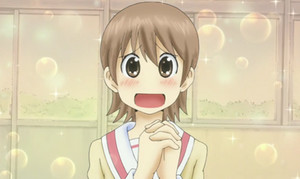
My Ordinary Life
Rating: 3
Based on the popular comedy manga Nichijou, My Ordinary Life is at first glance yet another Lucky Star gag show about cute little girls doing cute little girl stuff. That, coupled with an earplug demanding OP that seemingly goes on for about a month, makes it sound like the kind of anime I personally avoid.
However, first glances can be deceiving. Despite it not having the most original of premises, the show feels surprisingly polished and lovingly crafted. The writing is quite good for a start, and genuinely funny in places. Similarly it has a very gentle, warm art style that uses a soft, washed out palette of pastel colors that reminded me of Studio Ghibli's Only Yesterday. The character design might not be particularly innovative, but the calming art style does allow the animators to pull some contrasting and surprising tricks at times – within the first 3 minutes (and a couple more times throughout the episode) there's a literally explosive reference to the movie AKIRA, for example.
My Ordinary Life also isn't afraid to just pour on the wackiness at times. One of the main girls is in fact a robot with a giant wind-up key in her back, while some of the boys at school sport a selection of great haircuts, including perhaps one of the greatest afros ever depicted in animated form. At one point someone shouts – with grave sincerity – "Arriving by goat doesn't violate school policy!" A personal highlight for me was the mini 4-koma style cartoon that pops up halfway through the episode about a clueless Grim Reaper. All this kind of material is often a lazy substitute for laughs in comedy anime, but here it largely hits the mark – perhaps again because it feels polished and well paced.
An enjoyable first episode, but I'm not sure if I'd return for much more.
My Ordinary Life is available streaming at Crunchyroll.
discuss this in the forum (700 posts) |
this article has been modified since it was originally posted; see change history
back to The Spring 2011 Anime Preview Guide
Season Preview Guide homepage / archives